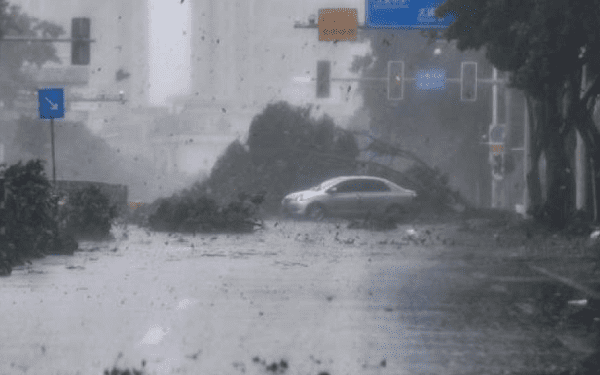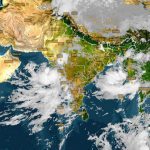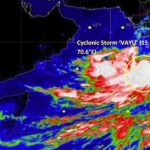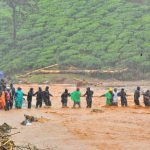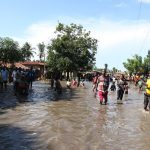Typhoon Bebinca made landfall in Shanghai at 7:30 a.m. on Monday, bringing strong gusts and heavy rains to the expansive Pudong business sector, with maximum speeds of 151 kph (94 mph) around the center.
Bebinca is being said to be the strongest typhoon to hit Shanghai since at least 1949.
Authorities say they expected the typhoon would also affect the nearby provinces of Zhejiang, Jiangsu and Anhui.
Over 400,000 people have been evacuated.

Flights, ferries and train services were suspended in the megacity and in neighboring provinces, disrupting travel during China’s three-day Mid-Autumn Festival.
Shanghai’s airports canceled hundreds of flights starting Sunday and through Monday, while in Hangzhou, about 170 kilometers (106 miles) southwest of Shanghai, authorities were also planning to cancel more than 180 flights.
Over 60,000 emergency responders and firefighters were at hand to lend aid in Shanghai, according to state media.
Strong typhoons rarely hit Shanghai, which has a population of 25 million people. They normally settle further south in China.
Typhoon Yagi struck China’s southern Hainan island earlier this month, wreaking havoc throughout Southeast Asia.
Yagi killed at least 74 people in Myanmar, and dozens more went missing. There were four reported deaths in Hainan, at least ten in Thailand, and twenty in the Philippines.
Vietnam has recorded over 230 deaths as a result of the storm and following flooding and landslides, with dozens more still missing.
Typhoon Bebinca made landfall in Shanghai at 7:30 a.m. on Monday, bringing strong gusts and heavy rains to the expansive Pudong business sector, with maximum speeds of 151 kph (94 mph) around the center.
Bebinca is being said to be the strongest typhoon to hit Shanghai since at least 1949.
Authorities say they expected the typhoon would also affect the nearby provinces of Zhejiang, Jiangsu and Anhui.
Over 400,000 people have been evacuated.

Flights, ferries and train services were suspended in the megacity and in neighboring provinces, disrupting travel during China’s three-day Mid-Autumn Festival.
Shanghai’s airports canceled hundreds of flights starting Sunday and through Monday, while in Hangzhou, about 170 kilometers (106 miles) southwest of Shanghai, authorities were also planning to cancel more than 180 flights.
Over 60,000 emergency responders and firefighters were at hand to lend aid in Shanghai, according to state media.
Strong typhoons rarely hit Shanghai, which has a population of 25 million people. They normally settle further south in China.
Typhoon Yagi struck China’s southern Hainan island earlier this month, wreaking havoc throughout Southeast Asia.
Yagi killed at least 74 people in Myanmar, and dozens more went missing. There were four reported deaths in Hainan, at least ten in Thailand, and twenty in the Philippines.
Vietnam has recorded over 230 deaths as a result of the storm and following flooding and landslides, with dozens more still missing.
Typhoon Bebinca made landfall in Shanghai at 7:30 a.m. on Monday, bringing strong gusts and heavy rains to the expansive Pudong business sector, with maximum speeds of 151 kph (94 mph) around the center.
Bebinca is being said to be the strongest typhoon to hit Shanghai since at least 1949.
Authorities say they expected the typhoon would also affect the nearby provinces of Zhejiang, Jiangsu and Anhui.
Over 400,000 people have been evacuated.

Flights, ferries and train services were suspended in the megacity and in neighboring provinces, disrupting travel during China’s three-day Mid-Autumn Festival.
Shanghai’s airports canceled hundreds of flights starting Sunday and through Monday, while in Hangzhou, about 170 kilometers (106 miles) southwest of Shanghai, authorities were also planning to cancel more than 180 flights.
Over 60,000 emergency responders and firefighters were at hand to lend aid in Shanghai, according to state media.
Strong typhoons rarely hit Shanghai, which has a population of 25 million people. They normally settle further south in China.
Typhoon Yagi struck China’s southern Hainan island earlier this month, wreaking havoc throughout Southeast Asia.
Yagi killed at least 74 people in Myanmar, and dozens more went missing. There were four reported deaths in Hainan, at least ten in Thailand, and twenty in the Philippines.
Vietnam has recorded over 230 deaths as a result of the storm and following flooding and landslides, with dozens more still missing.
Typhoon Bebinca made landfall in Shanghai at 7:30 a.m. on Monday, bringing strong gusts and heavy rains to the expansive Pudong business sector, with maximum speeds of 151 kph (94 mph) around the center.
Bebinca is being said to be the strongest typhoon to hit Shanghai since at least 1949.
Authorities say they expected the typhoon would also affect the nearby provinces of Zhejiang, Jiangsu and Anhui.
Over 400,000 people have been evacuated.

Flights, ferries and train services were suspended in the megacity and in neighboring provinces, disrupting travel during China’s three-day Mid-Autumn Festival.
Shanghai’s airports canceled hundreds of flights starting Sunday and through Monday, while in Hangzhou, about 170 kilometers (106 miles) southwest of Shanghai, authorities were also planning to cancel more than 180 flights.
Over 60,000 emergency responders and firefighters were at hand to lend aid in Shanghai, according to state media.
Strong typhoons rarely hit Shanghai, which has a population of 25 million people. They normally settle further south in China.
Typhoon Yagi struck China’s southern Hainan island earlier this month, wreaking havoc throughout Southeast Asia.
Yagi killed at least 74 people in Myanmar, and dozens more went missing. There were four reported deaths in Hainan, at least ten in Thailand, and twenty in the Philippines.
Vietnam has recorded over 230 deaths as a result of the storm and following flooding and landslides, with dozens more still missing.
Typhoon Bebinca made landfall in Shanghai at 7:30 a.m. on Monday, bringing strong gusts and heavy rains to the expansive Pudong business sector, with maximum speeds of 151 kph (94 mph) around the center.
Bebinca is being said to be the strongest typhoon to hit Shanghai since at least 1949.
Authorities say they expected the typhoon would also affect the nearby provinces of Zhejiang, Jiangsu and Anhui.
Over 400,000 people have been evacuated.

Flights, ferries and train services were suspended in the megacity and in neighboring provinces, disrupting travel during China’s three-day Mid-Autumn Festival.
Shanghai’s airports canceled hundreds of flights starting Sunday and through Monday, while in Hangzhou, about 170 kilometers (106 miles) southwest of Shanghai, authorities were also planning to cancel more than 180 flights.
Over 60,000 emergency responders and firefighters were at hand to lend aid in Shanghai, according to state media.
Strong typhoons rarely hit Shanghai, which has a population of 25 million people. They normally settle further south in China.
Typhoon Yagi struck China’s southern Hainan island earlier this month, wreaking havoc throughout Southeast Asia.
Yagi killed at least 74 people in Myanmar, and dozens more went missing. There were four reported deaths in Hainan, at least ten in Thailand, and twenty in the Philippines.
Vietnam has recorded over 230 deaths as a result of the storm and following flooding and landslides, with dozens more still missing.
Typhoon Bebinca made landfall in Shanghai at 7:30 a.m. on Monday, bringing strong gusts and heavy rains to the expansive Pudong business sector, with maximum speeds of 151 kph (94 mph) around the center.
Bebinca is being said to be the strongest typhoon to hit Shanghai since at least 1949.
Authorities say they expected the typhoon would also affect the nearby provinces of Zhejiang, Jiangsu and Anhui.
Over 400,000 people have been evacuated.

Flights, ferries and train services were suspended in the megacity and in neighboring provinces, disrupting travel during China’s three-day Mid-Autumn Festival.
Shanghai’s airports canceled hundreds of flights starting Sunday and through Monday, while in Hangzhou, about 170 kilometers (106 miles) southwest of Shanghai, authorities were also planning to cancel more than 180 flights.
Over 60,000 emergency responders and firefighters were at hand to lend aid in Shanghai, according to state media.
Strong typhoons rarely hit Shanghai, which has a population of 25 million people. They normally settle further south in China.
Typhoon Yagi struck China’s southern Hainan island earlier this month, wreaking havoc throughout Southeast Asia.
Yagi killed at least 74 people in Myanmar, and dozens more went missing. There were four reported deaths in Hainan, at least ten in Thailand, and twenty in the Philippines.
Vietnam has recorded over 230 deaths as a result of the storm and following flooding and landslides, with dozens more still missing.
Typhoon Bebinca made landfall in Shanghai at 7:30 a.m. on Monday, bringing strong gusts and heavy rains to the expansive Pudong business sector, with maximum speeds of 151 kph (94 mph) around the center.
Bebinca is being said to be the strongest typhoon to hit Shanghai since at least 1949.
Authorities say they expected the typhoon would also affect the nearby provinces of Zhejiang, Jiangsu and Anhui.
Over 400,000 people have been evacuated.

Flights, ferries and train services were suspended in the megacity and in neighboring provinces, disrupting travel during China’s three-day Mid-Autumn Festival.
Shanghai’s airports canceled hundreds of flights starting Sunday and through Monday, while in Hangzhou, about 170 kilometers (106 miles) southwest of Shanghai, authorities were also planning to cancel more than 180 flights.
Over 60,000 emergency responders and firefighters were at hand to lend aid in Shanghai, according to state media.
Strong typhoons rarely hit Shanghai, which has a population of 25 million people. They normally settle further south in China.
Typhoon Yagi struck China’s southern Hainan island earlier this month, wreaking havoc throughout Southeast Asia.
Yagi killed at least 74 people in Myanmar, and dozens more went missing. There were four reported deaths in Hainan, at least ten in Thailand, and twenty in the Philippines.
Vietnam has recorded over 230 deaths as a result of the storm and following flooding and landslides, with dozens more still missing.
Typhoon Bebinca made landfall in Shanghai at 7:30 a.m. on Monday, bringing strong gusts and heavy rains to the expansive Pudong business sector, with maximum speeds of 151 kph (94 mph) around the center.
Bebinca is being said to be the strongest typhoon to hit Shanghai since at least 1949.
Authorities say they expected the typhoon would also affect the nearby provinces of Zhejiang, Jiangsu and Anhui.
Over 400,000 people have been evacuated.

Flights, ferries and train services were suspended in the megacity and in neighboring provinces, disrupting travel during China’s three-day Mid-Autumn Festival.
Shanghai’s airports canceled hundreds of flights starting Sunday and through Monday, while in Hangzhou, about 170 kilometers (106 miles) southwest of Shanghai, authorities were also planning to cancel more than 180 flights.
Over 60,000 emergency responders and firefighters were at hand to lend aid in Shanghai, according to state media.
Strong typhoons rarely hit Shanghai, which has a population of 25 million people. They normally settle further south in China.
Typhoon Yagi struck China’s southern Hainan island earlier this month, wreaking havoc throughout Southeast Asia.
Yagi killed at least 74 people in Myanmar, and dozens more went missing. There were four reported deaths in Hainan, at least ten in Thailand, and twenty in the Philippines.
Vietnam has recorded over 230 deaths as a result of the storm and following flooding and landslides, with dozens more still missing.

